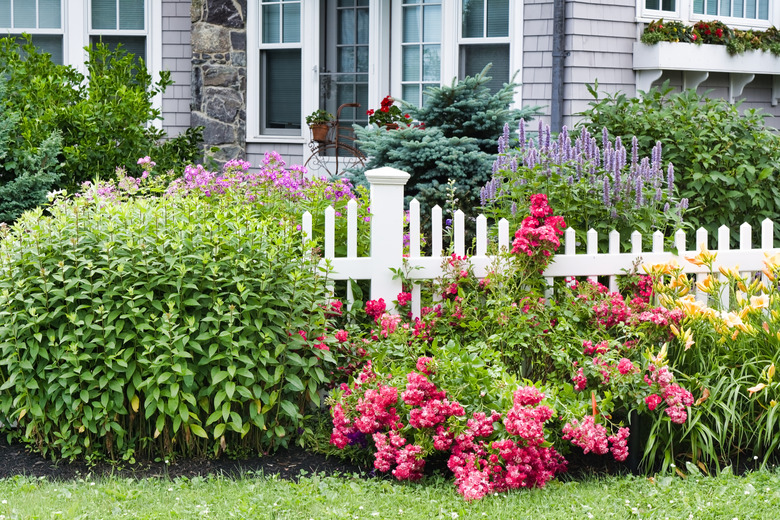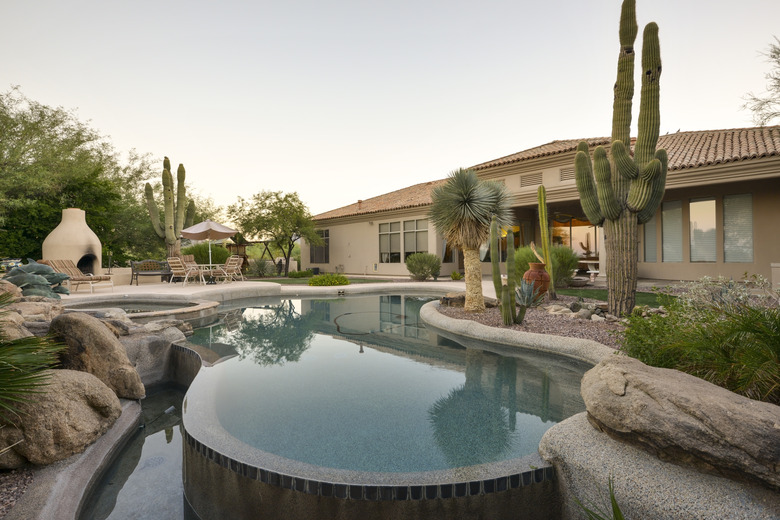Complete Guide To Landscape Design And Construction
We may receive a commission on purchases made from links.
Landscape design is very much an art form, but it's also a science, and like any science, it adheres to guiding principles, the main one being to work with nature and not against it. Unlike a building or a road, a landscape is alive, and every part of it interacts with every other piece as well as with the general surroundings. You're fighting with nature if you try to include elements that aren't compatible with each other or are unable to adapt to the local climate.
A typical landscape design combines living elements, such as shrubs, trees, grass and other ground cover — which together with the living soil are collectively called softscape — and nonliving hardscape elements, such as trellises, walls, walkways and rocks. If the design is an effective one, the hardscape forms the structure on or around which the softscape grows and thrives. A vibrant, colorful landscape can be a haven for birds, bees and small wildlife, a feast for the eyes, a shady refuge in summer, an inspiration for contemplation in winter and even a source of food.
Landscape Design Principles
Landscape Design Principles
If you're familiar with feng shui, the Chinese art of space harmonization, you'll also be familiar with the basic principles of Western landscape design because they aren't much different. Western design principles aren't as concerned with compass direction as feng shui — except for the direction of the sun — but they work toward many of the same goals. Richards Total Backyard Solutions explains some of the most important landscape design principles to which a landscape designer should adhere:
- Unity and repetition: The repetition of plants and other design elements in the landscape establishes a sense of consistency, which in turn helps to create a unique central theme or focal point.
- Balance: A landscaper creates balance by establishing a sense of equality and proportion among plants and hardscape décor.
- Color: Some colors excite the senses, such as those of a hydrangea in full bloom, and some, like the deep greens of an evergreen in an urban setting, can soothe them.
- Contrast and harmony: Contrasting shapes and colors create drama, while harmonic ones promote a sense of relaxation.
- Line: Perhaps the most important elements in landscape design, straight and curved lines delineate spaces and establish zones and perspective. Transitions between zones are rarely sharp but rather gradual, and when well planned, they provide texture.
- Proportion: The establishment of balance and unity is supported by attention to proportion. Any design element that is out of proportion to its setting looks out of place and ends up creating a disturbance.
A number of practical considerations are just as important as aesthetic design principles in the creation of a DIY landscape. A few of these are:
- Direction and intensity of the sun.
- Climate.
- Existing vegetation.
- Topography of the property.
Xeriscaping for Water Conservation
Xeriscaping for Water Conservation
If you live in an arid location or you just want to be water-conscious, you'll want to incorporate xeriscaping principles into your design. According to Water Use It Wisely, these include:
- Efficient irrigation to make the best use of limited water, including substituting a drip system for a sprinkler wherever possible.
- Incorporating low-water-use plants into your design.
- Keeping turf areas to a minimum.
- Using mulch to minimize water loss to the atmosphere.
Make a Landscape Design Plan
Make a Landscape Design Plan
It goes without saying that digital tools greatly simplify the task of drawing a landscape design, and many are available for free download so you can save the money for tools and supplies. Backyard Boss offers links to five useful tools. Of these, GARDENA is recommended as being the easiest to use, while the trial version of the popular SketchUp is perfect for one-time use.
Before the advent of app-based planning, a landscaper had to resort to paper and pencil, and many still prefer this nontechnical approach. The process involves the following steps:
- Draw the property outline on a sheet of 1/4- or 1/8-inch graph paper, assigning a suitable scale.
- Measure the locations of the main house, outbuildings and other permanent features with respect to the property lines using a 100-foot tape measure and transfer these to the drawing to get a base map of the property.
- Trace the drawing onto a clean sheet of tracing paper.
- Subdivide the free space into areas of potential use, such as play areas, outdoor kitchens, flower beds or water features.
- Draw oblong or circular figures within the spaces for the softscape and hardscape elements you plan to add. This is what Iowa State University Extension and Outreach calls a bubble diagram. It gives a more-or-less accurate idea of the layout of the elements and the spacing between them.
- Update the bubble diagram as new ideas occur to you.
Once you've finalized the bubble diagram, use it to make your shopping list. It will tell you quantities of softscape elements, such as ground cover and shrubbery, as well as hardscape elements, like pavers and gravel, that you need to buy.
Area-Specific Landscape Design Tips
Area-Specific Landscape Design Tips
Giving a nod to the directionality considerations that are important in feng shui, the areas in the front and back and to the sides of the main building have different design requirements. The front, being the gateway to the property, is the place for decorative foliage, such as foundation plantings, and accent lighting. Trees and large bushes should never block the walkway or the front door. Use hardscape features, such as pavers, pilasters or even an entry archway, to define the way into the house and to make it inviting.
The backyard is more of a personal and private space, and it's where you'll want to locate the patio, perhaps accented by a garden bed or a vegetable garden. To encourage appreciation of the space, construct walkways in the backyard that meander rather than proceed in straight lines. Water features, large shade trees and open spaces all help in their own way to complete a picture of serene outdoor living.
The side yard is often the part of the property that gets the least light, so if you plant there, be sure the plants can tolerate shade. The side of the house is usually a passageway from the front to the back, so it should have a walkway that is perhaps punctuated by a gate and, if you use pavers, adorned with a low-maintenance ground cover. It's probably where you store trash, so it should have a covered trash area, and if you have a vegetable garden, you can include a compost bin in the enclosure.
Gather Your Landscape Tools
Gather Your Landscape Tools
As your landscape matures, Penn Live reminds you that you'll need loppers and shears to remove dead branches, so you can wait a year before purchasing them, but at the beginning, you should invest in a good pair of bypass pruners because pruning is essential for the health and shape of young plants. You'll also need a round point shovel for digging, one or two square point shovels, a wheelbarrow for transferring materials and at least one garden trowel for planting seedlings.
If your landscape includes a lawn, it won't be long before it needs mowing, so invest in a lawn mower at the outset. If the grassy area is small, consider maintaining it with a battery-powered weed trimmer with an attachment for edging. Other handy maintenance tools include a leaf rake and a leaf blower.


